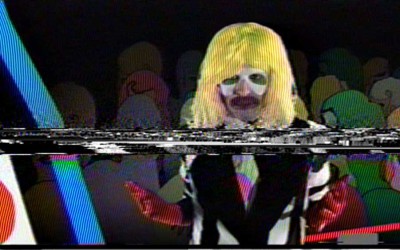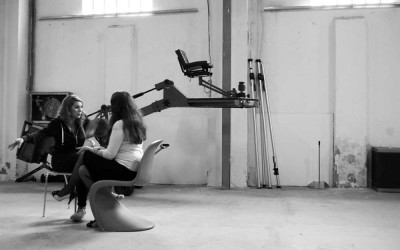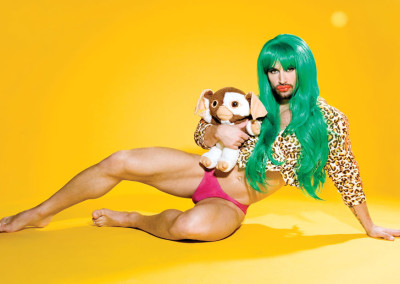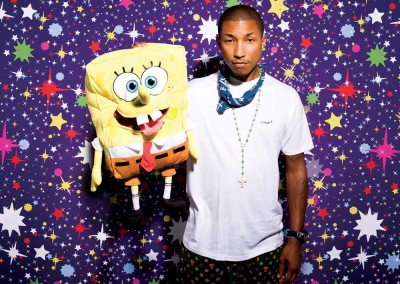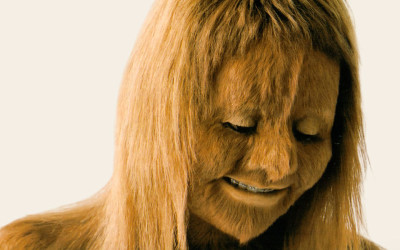The Trans*Tapes is a series of six short portraits about transgender people in the Netherlands, made by three transmen; Bart Peters, Jonah Lamers and Chris Rijksen. Released in 2015, The Trans*Tapes focus on strength, positivity and…..
Satyricon Beta
Satyricon Beta
Text JF. Pierets Photos Lukas Beyeler
“I’ve promised you the story of my adventures for a long time. Today I’m finally going to keep my word. My unhealthy curiosity and my depraved imagination are the true product of Roman immorality, which is the basis of your education.” These opening sentences are the start of a new video by one of Et Alors? Magazine’s favourite artists Lukas Beyeler. Satyricon or The Book of Satyrlike Adventures, is based on the work of fiction believed to have been written by Petronius Arbiter and shows us a highlighted version of Beyeler’s favourite scenes.
The video is a bit like a painting; you observe very slowly.
Originally the book was huge, but they lost quite a lot over time. Basically there are about 300 pages left. Speculation as to the size of the original puts it somewhere on the order of a work of thousands of pages. In the video I wanted to show that there is something missing, like an unfinished puzzle. It goes from one chapter to another without a clear story line. There’s no plot, nor a narrative, nothing that resembles a story. We just observe the protagonist going slowly from one scene to another. The slow rhythm is accentuated by my use of 120 frames per second. The stationary camera makes you feel that there is no fixed time.
Tell me about your work method when it comes to story telling?
After I read the book I just took the scenes which spoke to me the most. A lot of them are the ones that wouldn’t interest a hetero filmmaker. In one of them the witch provides the narrator with a cure for something you don’t know what it is. Maybe it’s syphilis, maybe gonorrhea, or maybe he’s just impotent. It’s a scene I very much liked, maybe it’s because you wouldn’t expect such scenes in a book where the action is happening before Christ. I often have the feeling that everything before Christ was in a way easier because there was no taboo, no religion, no morale, and everybody was bisexual. What you see is in that book is the sex habit and the social behaviour of the old Roman Empire. Most of them have no objective in their lives, no jobs. They just eat and have sex all the time.
Both Fellini and Polidoro tackled Satyricon in 1968 and 1969.
If you watch Fellini’s movie, it’s only about twenty percent of the actual story. The minotaur, the labyrinth and many other characters are nowhere to be found within’ the book. Gian Luigi Polidoro is much closer to the original text but replaced the gay character by a woman.
A true Hollywood phenomenon.
Indeed. When Disney makes a movie about Hercules, he’s of course one hundred per cent straight. But Hercules was bi in the texts. So there’s this straight-washing going on all the time. Same when movies or media talk about Da Vinci or Lincoln, there’s a lot of heterosexualising, if you can call it like that. I also guess that what we read now is very different from the original book. From BC till now, people copied the texts. And those scribes were often religious so sometimes when there was a sex scene, they would just leave it out. Some of them would even re-write the story the way they wanted it to be. Nobody will ever know how close the current text is from the original. So you know, after all this text massacre, incorrect Latin translation and straight-washing corrections: I thought, now I’m going write my own version where Ascyltos is the Main Character. And I’m going to let him having an affaire with whoever I want.
‘My work is about my environment, and of course part of it is a certain gay scene. It’s my life so in a way I just project my surrounding.’
You’re very outspoken about the gay-factor in your work.
My work is about my environment, and of course part of it is a certain gay scene. It’s my life so in a way I just project my surrounding. My inspiration comes from the people I work with. When I meet the right person: it just happens. The idea for Satyricon Beta has been going through my head for about two years now but I didn’t act upon it until I met the right people to do it. As there’s no rush to execute a project, I do not believe in casting for this kind of artistic projects. But when I see the right actor or model that can match a certain project then there’s no way back. I think there’s a special actor for any project, you just have to cross paths. Unfortunately I cannot change my ideas after that. I get obsessed with that person and I can be a real pain in the ass until they agree to do the project. I’m a stalker without a budget, so I guess people just have to trust me, or not.
Why did you choose to make the video in Italian?
I’ve read the book in Italian, in French and in English, and I chose to go for Italian because it’s the closest to Latin. Since my actor, Rocco Schira, is Swiss-Italian and is a voice talent, we had to use all that in the video. I wrote it in French, my mother tongue, translated it to Italian and subtitled in English. For me it was good to mix up all these languages because you really feel how it changes the text. I like to work with language and translations. They all have their different culture and colour which highly influences the image. You’ll find some text from Lucius Annaeus Seneca, some poems of Robert Lee Frost and of course some original parts of Gaius Petronius Arbiter. We also shot the video in Ticino, the Italian part of Switzerland. The nature is beautiful there, very Roman and completely cut of from the rest of the world. Not an easy place to live in but a great location to shoot.
Satyricon Beta will be shown at the Queer Biennial II in LA. What happens after that?
I’m very happy to premiere that video in Los Angeles at the Biennial, but ‘after that’ to tell you the truth:
I have no idea. Sometimes the work travels to other festivals or is screened in other gallery spaces but you never know if it’s gonna work or die there. My biggest problem in this creative process is that when I’m done, I’m done ! The showing of the work doesn’t interest me much, it’s not part of the work itself anymore. That’s why I’m not the best seller of my own work: I love to make it but I always feel way to vulnerable to take it on display. It shows too much of myself. When a project is finished, I’m just starting something else. My part is to create, to shoot, to edit and to spend time with people making it. You think I should get an agent?
www.queerbiennial.com
www.lukasbeyeler.com
Satyricon Beta
2016, Full HD, 16/9, 21min
Written and directed by Lukas Beyeler
Ascyltos Rocco Schira
Oenothea Nils Amadeus Lange
Camera operator Carlotta Holy
Voice over Rocco Schira & Ayana Glam
Subtitles Anja Draeger
Related articles
The Trans*Tapes
Satyricon Beta
“I’ve promised you the story of my adventures for a long time. Today I’m finally going to keep my word. My unhealthy curiosity and my depraved imagination are the true product of Roman immorality, which is the basis of your education.” These…..
Wonderkid
There are 5000 footballers in the UK and not one of them is openly gay. Clubs prevent players from coming out because of an elegit increasing commercial market value, which may be damaging to both the sport as to its players. Not only…..
Rolla Selbak
Up till now she has made 2 feature films, a bunch of short films, a music video and 2 seasons of ‘Kiss her I’m famous’. The Spreecast ‘Grrls guide to filmmaking’ in which she interviews female movie directors, turned into a docu series and…..
Marina Rice Bader
Executive Producer of the lesbian themed movies ‘Elena Undone’ and ‘A Perfect Ending’, Marina Rice Bader, is releasing her feature length directorial debut ‘Anatomy of a Love Seen’ as a streaming rental, breaking outside of and bypassing the traditional…..
One Zero One
One Zero One is Tim Lienhard’s first independent feature film starring Cybersissy and BayBjane. This 90-minutes long documen-tale tells a true story about a most unique friendship, about survival at the edge of society and about the final…..
Live Nude Dancing
Live Nude Dancing is a collaboration between photographer Daniel Trese, choreographer Ryan Heffington and animator Johnny Woods. Commissioned by MOCAtv. The film is based on a piece from Heffington’s critically acclaimed show KTCHN that…..
Ed Wood
Since the biopic ‘Ed Wood’ starring Johnny Depp, the for nearly two decades forgotten eccentric of the 1950s, Edward D. Wood Jr. enjoyed a success that quite escaped him in life. His technically inept, but oddly fascinating films are shown at…..
Erika Lust
Someone once told her that she must be the cutest porn director he ever met. She thought that was a good thing, because most people still think you have to be a freak to make this kind of movies. We’re in Barcelona, in a huge loft. During lunchtime…..
Children of Srikandi
Children of Srikandi is the first film about queer women in Indonesia, the country with the worlds largest Muslim population. Eight authentic and poetic stories are interwoven with beautiful shadow theater scenes that tell the story of…..





